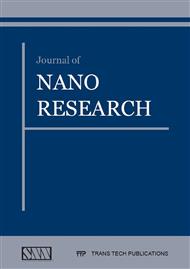[1]
K. Nawamawat, J.T. Sakdapipanich, C.C. Ho, Y. Ma, J. Song, J.G. Vancso, Surface nanostructure of Hevea brasiliensis natural rubber latex particles, Colloid. Surfaces A, 390 (2011) 157-166.
DOI: 10.1016/j.colsurfa.2011.09.021
Google Scholar
[2]
V.V. Rajan, W.K. Dierkes, R. Joseph, J.W.M. Noordermeer, Science and technology of rubber reclamation with special attention to NR-based waste latex products, Prog. Polym. Sci., 31 (2006) 811-834.
DOI: 10.1016/j.progpolymsci.2006.08.003
Google Scholar
[3]
K. Sanguansap, T. Suteewong, P. Saendee, U. Buranabunya, P. Tangboriboonrat, Composite natural rubber based latex particles: a novel approach, Polymer, 46 (2005) 1373-1378.
DOI: 10.1016/j.polymer.2004.11.074
Google Scholar
[4]
N.K. On, A.A. Rashid, M.M.M. Nazlan, H. Hamdan, Thermal and mechanical behavior of natural rubber latex-silica aerogel film, J. Appl. Polym. Sci., 124 (2012) 3108-3116.
DOI: 10.1002/app.35354
Google Scholar
[5]
K. Songsing, T. Vatanatham, N. Hansupalak, Kinetics and mechanism of grafting styrene onto natural rubber in emulsion polymerization using cumene hydroperoxide–tetraethylenepentamine as redox initiator, Eur. Polym. J., 49 (2013) 1007-1016.
DOI: 10.1016/j.eurpolymj.2013.01.027
Google Scholar
[6]
M. Singh, J. Esquena, C. Solans, K. Booten, T.F. Tadros, Influence of hydrophobically modified inulin (INUTEC NRA) on the stability of vulcanized natural rubber latex, Colloid Surface A, 451 (2014) 90-100.
DOI: 10.1016/j.colsurfa.2014.03.057
Google Scholar
[7]
S.S. Ochigbo, A.S. Luyt, W.W. Focke, Latex derived blends of poly(vinyl acetate) and natural rubber: thermal and mechanical properties, J. Mater. Sci., 44 (2009) 3248-3254.
DOI: 10.1007/s10853-009-3435-6
Google Scholar
[8]
T. Pojanavaraphan, L. Liu, D. Ceylan, O. Okay, R. Magaraphan, D.A. Schiraldi, Solution Cross-Linked Natural Rubber (NR)/Clay Aerogel Composites, Macromolecules, 44 (2011) 923-931.
DOI: 10.1021/ma102443k
Google Scholar
[9]
J.R. Potts, O. Shankar, L. Du, R.S. Ruoff, Processing-Morphology-Property Relationships and Composite Theory Analysis of Reduced Graphene Oxide/Natural Rubber Nanocomposites, Macromolecules, 45 (2012) 6045-6055.
DOI: 10.1021/ma300706k
Google Scholar
[10]
L. Kong, Z. Peng, S. -D. Li, P.M. Bartold, Nanotechnology and its role in the management of periodontal diseases, Periodontol 2000, 40 (2006) 184-196.
DOI: 10.1111/j.1600-0757.2005.00143.x
Google Scholar
[11]
Y. Ikedai, Y. Kameda, Preparation of Green Composites by the Sol-Gel Process In Situ Silica Filled Natural Rubber, J. Sol-Gel Sci. Techn., 31 (2004) 137-142.
DOI: 10.1023/b:jsst.0000047975.48812.1b
Google Scholar
[12]
J. Ramier, C. Gauthier, L. Chazeau, L. Stelandre, L. Guy, Payne effect in silica-filled styrene-butadiene rubber: Influence of surface treatment, J. Polym. Sci. Polym. Phys., 45 (2007) 286-298.
DOI: 10.1002/polb.21033
Google Scholar
[13]
D. Fragiadakis, L. Bokobza, P. Pissis, Dynamics near the filler surface in natural rubber-silica nanocomposites, Polymer, 52 (2011) 3175-3182.
DOI: 10.1016/j.polymer.2011.04.045
Google Scholar
[14]
L. Wahba, M. D'Arienzo, R. Donetti, T. Hanel, R. Scotti, L. Tadiello, F. Morazzoni, In situ sol-gel obtained silica-rubber nanocomposites: influence of the filler precursors on the improvement of the mechanical properties, RSC Adv., 3 (2013).
DOI: 10.1039/c3ra22706e
Google Scholar
[15]
A. Tohsan, P. Phinyocheep, S. Kittipoom, W. Pattanasiriwisawa, Y. Ikeda, Novel biphasic structured composite prepared byin situsilica filling in natural rubber latex, Polym. Advan. Technol., 23 (2012) 1335-1342.
DOI: 10.1002/pat.2051
Google Scholar
[16]
P. Weng, Q. Wei, Z. Tang, T. Lin, B. Guo, The influence of molybdenum disulfide nanoplatelets on the dispersion of nano silica in natural rubber composites, Appl. Surf. Sci., 359 (2015) 782-789.
DOI: 10.1016/j.apsusc.2015.10.172
Google Scholar
[17]
M.C.W. Somaratne, N.M.V.K. Liyanage, S. Walpalage, Contribution of hydrogen and/or covalent bonds on reinforcement of natural rubber latex films with surface modified silica, J. Appl. Polym. Sci., 131 (2014) 40380.
DOI: 10.1002/app.40380
Google Scholar
[18]
Z. Peng, L.X. Kong, S. -D. Li, Y. Chen, M.F. Huang, Self-assembled natural rubber/silica nanocomposites: Its preparation and characterization, Compos. Sci. Technol., 67 (2007) 3130-3139.
DOI: 10.1016/j.compscitech.2007.04.016
Google Scholar
[19]
A.R. Hajipour, F. Mohammadsaleh, Polyvinyl alcohol-stabilized cuprous oxide particles: efficient and recyclable heterogeneous catalyst for azide-alkyne cycloaddition in water at room temperature, J. Iran. Chem. Soc., 12 (2015) 1339-1345.
DOI: 10.1007/s13738-015-0599-7
Google Scholar
[20]
P. Fatehi, A. Tutus, H. Xiao, Cationic modified PVA as a dry strength additive for rice straw fibers, Bioresource Technol., 100 (2009) 749-755.
DOI: 10.1016/j.biortech.2008.07.042
Google Scholar
[21]
J. Sun, X. Tian, P. Feng, S. Gong, Y. Yuan, Preparation of Low-Allergen Natural rubber Latex by Transglutaminase Catalysis, J. Appl. Polym. Sci., 129 (2013) 2404-2410.
DOI: 10.1002/app.38963
Google Scholar
[22]
W. Pichayakorn, J. Suksaeree, P. Boonme, W. Taweepreda, G.C. Ritthidej, Preparation of Deproteinized Natural Rubber Latex and Properties of Films Formed by Itself and Several Adhesive Polymer Blends, Ind. Eng. Chem. Res., 51 (2012) 13393-13404.
DOI: 10.1021/ie301985y
Google Scholar
[23]
Z. Peng, L.X. Kong, A thermal degradation mechanism of polyvinyl alcohol/silica nanocomposites, Polym. Degrad. Stabil., 92 (2007) 1061-1071.
DOI: 10.1016/j.polymdegradstab.2007.02.012
Google Scholar
[24]
X. She, C. He, Z. Peng, L. Kong, Molecular-level dispersion of graphene into epoxidized natural rubber: Morphology, interfacial interaction and mechanical reinforcement, Polymer, 55 (2014) 6803-6810.
DOI: 10.1016/j.polymer.2014.10.054
Google Scholar


